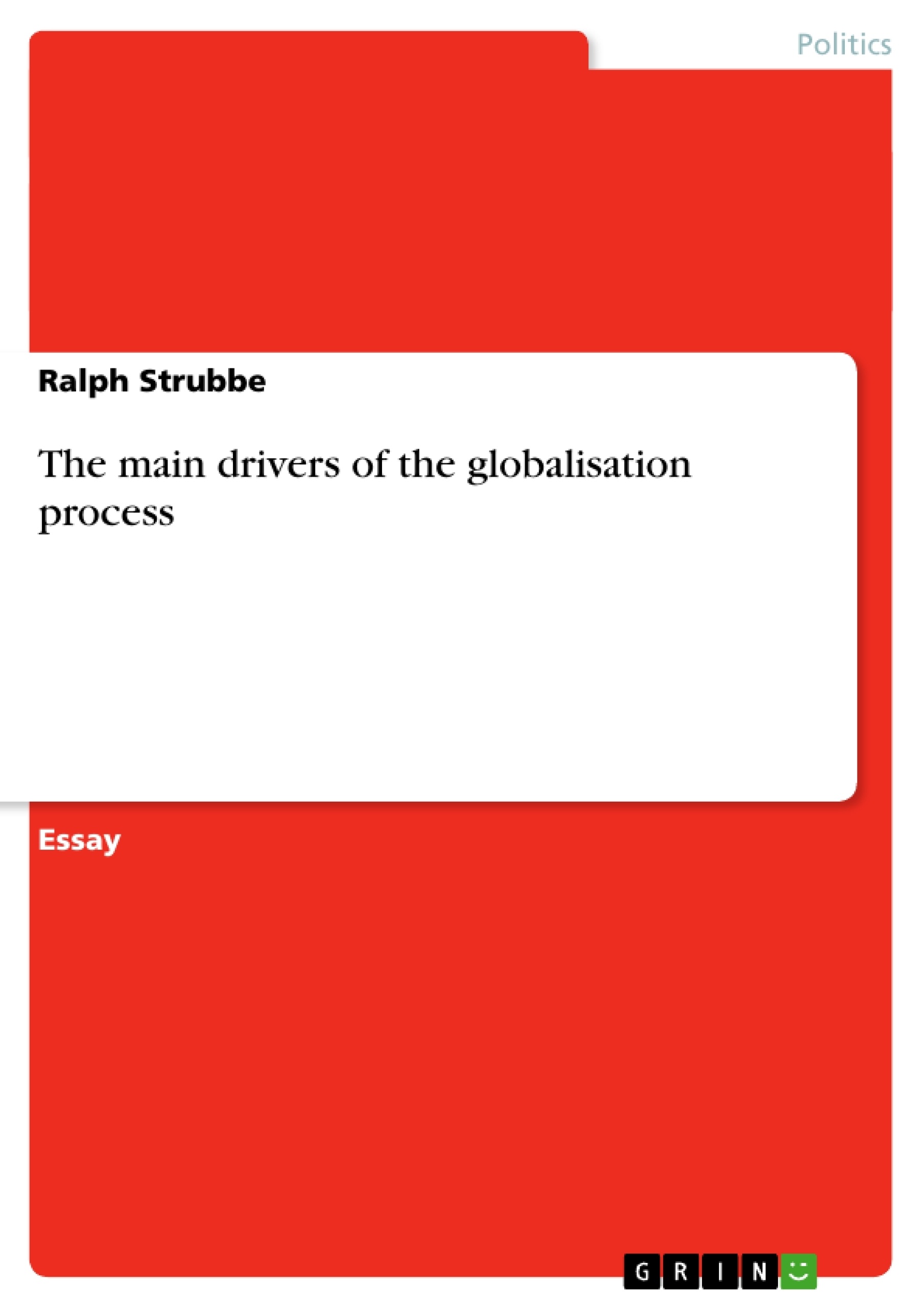Critically assessing the main drivers of the globalization process is the general purpose of this essay. As a start it seems sensible to basically identify all main drivers. After a short justification of the choice of the one driver, this driver will be described and evaluated in detail. A concise summary will conclude this essay.
1. Introduction
“We need to make our States stronger and more effective at the national level. And we need to get them working together on global issues [...]” (United Nations Press Release SG/SM/7343 GA/9705, 2000, no page).
By saying this Kofi Annan addressed globalization related issues and emphasized the relevance of global governance at the same time.
Critically assessing the main drivers of the globalization process is the general purpose of this essay. As a start it seems sensible to basically identify all main drivers. After a short justification of the choice of the one driver, this driver will be described and evaluated in detail. A concise summary will conclude this essay.
However, first of all, the meaning of ´globalization´ shall be clarified.
Although there is no precise and undisputed definition, it is possible to illustrate specific characteristics, hence, approaching a definition in this way. The roots of globalization reach far back. The characteristics of globalization has been visible already before World War One, however their development has accelerated (Dicken 2011). In an extensive use globalization could be described as an expanded and deepened interaction of humankind in sectors like culture, integrity, environment, agility and economic (Brühl and Rittberger, no date). In a finite use globalization could be seen as an increased integration of the economic world, which is reflected in a greater mutual interdependence across the globe. This interdependence becomes manifest in the increased cross-frontier transactions. (Brühl and Rittberger, no date; Johnson and Turner 2010; Dicken 2011; IMF 2008; Colander 2005).
Globalization is a multilayered “process and a destination” (Axtmann 1998, p. 1), which bears several challenges being on the horizon. Furthermore it is a process, which is mainly affected by several key aspects, the drivers.
2. Drivers of the globalization process
This chapter is supposed to identify these main drivers for the globalization process as well as specify the single main driver, which will be assessed particularly in chapter 4. It also contains an explanation why this driver was selected by the author.
Some writers centre particular aspects of the globalization process in their writings, for instance, Dicken (2011) focuses on the economic issues of globalization; Chatterji and Gangopadhyay (2005, p. 1) even examine “seven key aspects” of globalization. Even though there are diverse approaches, in this aspect the at hand essay follows Johnson and Turner (2010), who identify five key drivers for the globalization process, such as: “The Changing Economic Paradigm – from Demand Management to Neo-liberalism” (p. 21), “Finance and Capital Spread” (p. 24), “The Diffusion of Information and Communications Technology” (p. 25), “Social and Cultural Convergence” (p. 26) and the extension of international and global governance.
At first glance a vastly expanded world trade looks like the incitement of globalization. However, stimulating and even enabling these enlarged world trade interconnections were a case of political conjunctures and factors (Höffe 2007). As the paradigm of neo-liberalism and its notion of open markets have already captured most of the developed and developing countries (Dicken 2011), it is obvious that this development is now a matter of the past. This becomes even clearer when considering that even China opens its markets more and more, although the political system is far from being orientated at western world´s mainstream. It is very unlikely that this development will turn around. (Johnson and Turner 2010). Furthermore the spread of finance and the development of technology support the globalization process, but these aspects rather accelerate the process of globalization than actually originating it (Johnson and Turner 2010; Chatterji and Gangopadhyay 2005). By the way, Finance might even threatens the globalization process approaches, considering the problems the crisis of 2008 brought about (Dicken 2011). Convergence of cultural and social aspects can be seen as a result of opportunities offered by globalization. For instance, marketers use these possibilities, such as instant communication, for creating world products, which preferably sell across the whole globe. (Johnson and Turner 2010).
In short, the “neo-liberal, free-market ideology” (Dicken 2011, p. 2) was the precondition, on which globalization could emerge. The spread of finance and the development of the information and communication technology are catalysers for globalization. Convergence of social and cultural aspects are only consequences; hence, the international and global governance is the most important driver for the globalization process these days and in the future as it addresses the existing and upcoming challenges of the world (EU Institute for Security Studies 2010).
There are several more practical arguments like the above mentioned, for instance, that in an age of globalization only international institutions are able to reshape the business environment for enterprises, while the national states being unable to cope with the enlarged scope (Johnson and Turner 2010).
3. The expansion of International and Global Governance
A report of the Institute for Security Studies, an agency of the EU, (2010, p. 11) states “global governance – the collective management of common problems at the international level” is needed to cope with emerging challenges, which are at least partly influenced by globalization, like “climate change, energy security, food and water scarcity” and “migration flows”.
[...]
- Citar trabajo
- Ralph Strubbe (Autor), 2012, The main drivers of the globalisation process, Múnich, GRIN Verlag, https://www.grin.com/document/209585
-

-

-

-
¡Carge sus propios textos! Gane dinero y un iPhone X. -

-
¡Carge sus propios textos! Gane dinero y un iPhone X. -

-
¡Carge sus propios textos! Gane dinero y un iPhone X. -

-
¡Carge sus propios textos! Gane dinero y un iPhone X. -

-
¡Carge sus propios textos! Gane dinero y un iPhone X.

